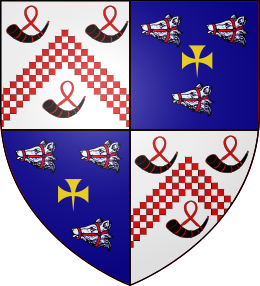Clan Sempill facts for kids
Quick facts for kids Clan Sempill |
|
|---|---|
| Motto | Keep Tryst |
| Profile | |
| Region | Lowlands |
| District | Renfrewshire |
| Chief | |
 |
|
| The Rt. Hon. James William Stuart Whitmore Sempill | |
| The 21st Lord Sempill | |
| Seat | Craigievar Castle |
| Historic seat | Castle Semple |
Clan Sempill is a historic Scottish clan from the Scottish Lowlands. Clans are like big families that have been around for a very long time in Scotland. The Sempill family has a rich history filled with brave knights and important leaders.
Contents
The Story of Clan Sempill
Where Did the Sempills Come From?

The Sempill name has been known in Renfrewshire since the 1100s. No one is completely sure where the name came from. Some ideas, like it meaning 'St Paul' or 'humble', are probably not true.
The first Sempill we know about was Robert de Sempill. In 1246, he signed an important document for Paisley Abbey. He also worked as a chamberlain, which was a high-ranking job, for the Earl of Lennox.
Fighting for Scottish Freedom
During the Wars of Scottish Independence, Robert de Sempill's two sons, Robert and Thomas, bravely supported King Robert the Bruce. They were both rewarded for their loyalty. The older son received land near Largs in Ayrshire. This land had been taken from the Balliols, who were against the King.
Thomas, the younger son, was given half of the lands of Longniddry. Before 1344, the Sempills also gained the lands of Eliotsoun. This place later became the official home of the clan chief.
Important Sempills in the 1400s and 1500s
Sir Thomas Sempill was a brave knight. He died fighting for King James III of Scotland at the Battle of Sauchieburn in June 1488. His only son, John Sempill, then took over the family's lands.
John Sempill, the First Lord Sempill
King James IV of Scotland made John Sempill a Lord Sempill. This was a very important title. In 1505, John started a church called the Collegiate church in Lochwinnoch. He also rebuilt a castle at the end of the loch and named it Castle Sempill.
Sadly, John Sempill was killed fighting for the king at the Battle of Flodden in 1513.
William Sempill and Mary, Queen of Scots
John's son, William, became the next Lord Sempill. He received his title with help from the Regent Albany. William thought it would be a good idea for the young Mary, Queen of Scots to marry the son of Henry VIII of England.
Robert Sempill, the "Great Lord"
William's son, Robert Sempill, was in charge of the king's Douglas Castle. He was captured at the Battle of Pinkie Cleugh in 1547. Robert was sometimes called the "Great Lord Sempill." He supported the Queen Regent, Mary of Guise, who was the mother of Mary, Queen of Scots.
Robert's castle was attacked because he was against the Scottish Reformation. He stayed loyal to Queen Mary until her husband, Lord Darnley, died. After that, he joined those who wanted Mary's son, James VI, to be king.
He fought against Queen Mary at the Battle of Carberry Hill. He was one of the people who signed the order for the queen to be held in Loch Leven Castle. He also led the front part of the army at the Battle of Langside in 1568. For his loyalty, he was given lands from Paisley Abbey. He was put in prison for a year after the Regent was killed in 1570.
John Sempill, "the Dancer"
Robert's son, John Sempill, was known as Sempill "the dancer." He was accused of treason and trying to kill Regent Morton. He was sentenced to death, but his punishment was changed to prison time. He was later set free.
Robert Sempill, Ambassador to Spain
In 1572, John was followed by his older half-brother, Robert Sempill, who became the fourth Lord Sempill. This Robert helped with the baptism of Prince Henry in 1594. He also attended a big celebration banquet for the queen at Stirling Castle.
King James VI of Scotland made Robert a Privy Councillor, which meant he advised the king. Robert was also sent as an ambassador to Spain. However, Robert would not give up his Catholic faith, so he did not hold any more public jobs.
The Sempills in the 1600s
Robert Sempill, the 6th Lord Sempill, supported the king during the Civil War. Because of this, he had to pay a fine when the Commonwealth took power. The 8th Lord Sempill became a Protestant. He was the first Lord Sempill to be in Parliament since the time of Mary, Queen of Scots. He died in 1684, and his sister, Anne Sempill, became the next head of the family.
The 1700s and Jacobite Risings
Anne's oldest son was Francis, the tenth Lord Sempill. He was strongly against Scotland joining with England. He died without marrying, so his brother, John Sempill, became the next Lord.
John Sempill supported the British Government during the Jacobite rising of 1715. John also died without marrying. The title then went to his brother, Hew (Hugh), who was a professional soldier. Hew Sempill was well-known for fighting in Europe. In 1746, he led his regiment for the British Government at the Battle of Culloden. His soldiers were on the left side of the government army.
Clan Chief
The current chief of Clan Sempill is The Rt Hon The Lord Sempill, James William Stuart Whitmore Sempill. He is the 21st Lord Sempill.
Clan Castles
- Craigievar Castle is the main home of the Clan Sempill chief today.
- Castle Sempill was an older home for the chief.
Sempill Surname Variations
Besides Sempill, you might see the name spelled in other ways. These include: Semple, Sample, Samples, Sampler, Simpole, Simble, and Sambell.
See also
- Scottish clan name variants also include Sempel & Sempell

